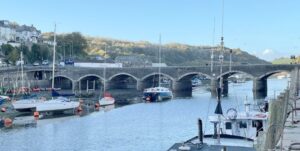 Looe Bridge
Looe Bridge
This is largely an article of personal memories and is in no way an attempt to provide a history of the area. It includes my first memories but is muddled with later visits and holidays with relations at Lanreath and Looe.
Alright, I’ll come clean, I didn’t do a lot of growing up while we were there as we left the area before my sixth birthday. However, I have made many return visits and it is a place which is indelibly etched on my memory and, more importantly, on my heart.
We moved to Trevathick Cottage from down west in 1947, long before I can remember anything about the world I had been born into. Consequently, my first memories are of the place and of my idyllic childhood.
My father had taken a job on Trenderway Farm, and Trevathick was our tied-cottage located between Looe and Pelynt. Major Kennington owned the farm. I don’t recall much about him except that he was tall, isn’t everyone when you are small, and there were whispers that he was once a British spy. Exciting stuff for a young boy.
Our cottage was located down a long lane as shown on the location map. It was a long walk from the farm, and from West Watergate where my Gran Merrifield lived with her son, my Uncle John. My Aunty Gladys was the Major’s housekeeper and I recall sleepovers both there and at my Gran’s.
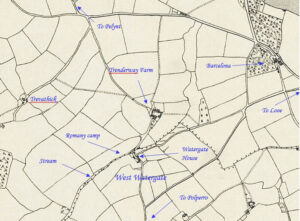
At Trevathick there was my Mum and Dad, Doug and Muriel (Mu), my elder brother, David, myself and a variety of cats, dogs, pigs and chicken. I recall letting the pigs out of their shed just before we were about to catch the bus to Looe. We missed the bus and it’s fair to say that our Dad was not too pleased. David was nearly four years older than me so I guess he took most of the blame. The chickens, too, were fair game as we chased them around the upper floor of the barn until they disappeared through a hatch and flew to the ground floor. All innocent fun – except for the chickens! Oh, and I nearly forgot, we had a fox as well. Well, no, that’s not quite right, he wasn’t exactly ours. He, or she, could often be found near the stream beyond our cottage and despite our best attempts, didn’t seem to want to be friends with us.
Trenderway Farm was a magical place with all manner of things for this young boy to explore. A little further along the narrow lane, past the eerie quarry which was apparently haunted (thanks David) and across the narrow footbridge over a shallow stream, was West Watergate. It was a place we came to know almost as well as Trevathick. Our Gran and Uncle John lived in the semi-detached cottage on the left with Mr and Mrs Heinz Volkelt in the adjoining cottage (also tied-cottages belonging to Trenderway Farm). I think that Heinz was either German or Polish and both he and my Uncle John also worked at Trenderway. Across the road from them were the Paynes and a little further up the hill were Mr and Mrs Hart. I remember Mr Hart making me a wooden tipping lorry and I thought that he was the best carpenter in the world.
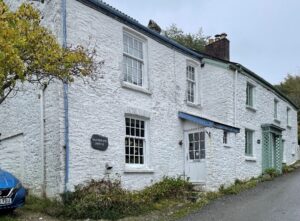 Gran Merrifield and Uncle John lived in the cottage on the left with the Volkelts next door
Gran Merrifield and Uncle John lived in the cottage on the left with the Volkelts next door
David recalled that on one of our many visits to our Gran’s we were playing near the chickens in the field behind the cottage and we decided to let them out of their run. He said, “We gave the excuse that they flew over the fence but unfortunately for us, Heinz Volkelt was at Trenderway Farm, just up the hill, and saw what had happened. Uncle John and Dad weren’t best pleased as they both had to round them up before the fox got them.”
Next to Gran’s cottage was the lane where David learned to ride a bike. It was a direct route to Barcelona (1) where there was a blacksmith shop. It no longer has that use but modern maps still show it as a Smithy. It was a place of wonder for us young boys as we watched the metal in the forge change colour before the blacksmith withdrew it from the fire and hammered it into shape. It is often the case that a wheelwright’s shop is close by, so that the carpenter and blacksmith can work together in making wheels, but I don’t recall ever seeing any being made.
Below the cottages was the stream which ran beside the lane to Crumplehorn and Polperro. A little way along this lane was a spot where the Romany Gypsies camped on their annual visits. Two traditional Romany caravans arrived, signalling it was the time for folk to bring their knives and scissors for sharpening. It was a time when parents warned their children to behave or the gypsies would get them but that threat had not reached our ears because we became good friends with the children and were sad to see them leave.
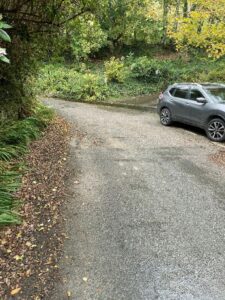 The lane and stream (very low in water) from West Watergate to Crumplehorn and Polperro
The lane and stream (very low in water) from West Watergate to Crumplehorn and Polperro
In January 1951 I turned five and it was time to start my schooling – at Pelynt (Plint). David had been attending there for a few years so that helped my confidence but I don’t recall being too impressed at having to catch the bus which wound its way along the narrow road to the front door of this huge place of learning. Perhaps my early dislike of school and its discipline has been wiped from my mind as I remember little about it apart from where we had our lunch (in those days it was certainly dinner). The hall was a short distance from the school and we had to walk two-abreast along the pavement. David reminded me that he once broke rank and stepped off the pavement onto the road. Unfortunately, the headmaster, Dickie Luftmann, spotted him and he had to write a thousand words “I must not step off the pavement”. There was clearly some confusion as David ended up writing a thousand lines!
 Our dinner hall at Pelynt
Our dinner hall at Pelynt
A particular favourite outing for us was a visit to Talland where our friends, the Greenwoods lived. Peter Greenwood had a rowing boat and it was always fun when he and Dad pushed us out some distance from the beach and then hauled us back to shore using a rope. I guess that it was a case of getting the timing right as the boat was holed and we had great fun in watching it fill with water. I have often joked that I guess they were trying to drown us. Also at Talland was a Church with its own ghost, allegedly!
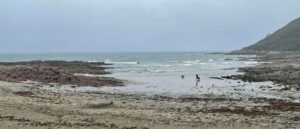 Talland
Talland
In 1951 Mr Kennington decided to sell Trenderway Farm and my father and the other farm workers had to leave their tied-cottages. I’m sure that I had no understanding of how precarious our housing situation was. Dad was faced with finding a new job and a new home for his family. Our cousin, Tony Paddy, was instrumental in this and we were soon heading west again, to a little village called Silverwell in the parish of St Agnes. I do not exaggerate when I say that the move was traumatic for David and myself. The tears flowed and the protests were long and loud. Looking back this could only have added to the anguish suffered by our parents but we were leaving a place which we loved and moving away from relations and friends we knew so well.
David recalled, “I had a pet rabbit at Trevathick: either a Danish or Russian Blue. For some reason we couldn’t take it with us when we moved and I had to give it to a friend. He lived on a farm opposite Sclerder Abbey, near Barcelona, where we used to go for the annual fetes or open days. I know it broke my heart to give him up.”
Turning now to Looe, and there could be no better turn as far as I am concerned. It was always the place to go for a day out and it became our town. The bus from Pelynt passed the end of our lane and then trundled along, through the little hamlet of Barcelona, joined the Polperro to Looe road and eventually descended the steep hill into that magical town. The excitement of that experience has not diminished.
My brother, David, was born in Looe. Perhaps I should explain that we were half-brothers, but apart from having a different surname, he is a full brother as far as I am concerned and was always treated as a son by my father. Our mother had been widowed in the Second World War when her husband was serving on a supply ship torpedoed by a German submarine.
Whilst living at Trevathick, and during our many return visits to the area, Looe seemed like a place out of time. Of course it has modernised but I have always felt that I was returning to my roots, to a place where I belonged. So many features and so many memories that simply do not fade. The hours and hours on Looe Beach where despite all my efforts, I never learnt to swim properly. It was a place where we played in the sand, built sandcastles, met other children and ate Martin’s ice cream.
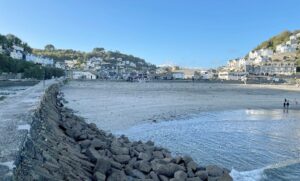 Looe Beach from the Banjo Pier
Looe Beach from the Banjo Pier
Then there was the fishing trip which ended with me being ordered off Looe Island. It has the other names of St Michael’s and St George’s but these seem very Anglicized so my preference is Looe Island. Perhaps, though, Logh would be even more appropriate if we follow my reasoning to its logical conclusion. Anyway, as to my ejection from the island. I need to paint the scene of two adults, my Dad and my Uncle John, and us boys, fishing for mackerel off Looe. The seven-year-old, that’s me, decided that the vast expanse of water was having an effect on me – no, not sea-sick… I needed a pee. Despite the arguments of the adults that my small contribution would not affect the sea levels, I could not be persuaded to do what they suggested. “Right”, said my uncle, “we’ll put into the island and you can go behind a tree or something”. This seemed like an ideal solution until, that is, I met the long arm of island authority. I think he carried a shotgun but I can’t be sure of that. Anyway, he made it quite clear that I was not going to be able to relieve myself on his island. Red faced, I scampered back to the boat and, you know what, the urge had passed.
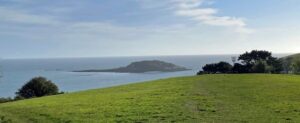 Looe Island
Looe Island
There were river trips, often when David and I holidayed at West Looe with Uncle John and Aunty Barbara and their sons, David and Colin. Our Aunty was a Looe fisherman’s daughter but I don’t recall using her Dad’s boat so Uncle John no doubt begged, borrowed or hired one. On one occasion we left West Looe, passed under Looe Bridge, waved to the steam train in Looe Station and motored up the East Looe River as far as we could go – the banks almost touching on both sides. Another time we turned left after the Millpool and explored the West Looe River – to Watergate and beyond. I thought that this stretch of water was beautiful.
To cross from West to East Looe we either walked to the bridge or took a ride on one of the ferry boats. The short trip by boat is popular with visitors and, certainly, with us. At very low tide the water is so shallow, and the trip is so short, that the boatman dons his waders and pushes the boat across. This area, on West Looe side, is known as Pennyland and my understanding since childhood is that this was based on the fare many years ago. This is an opinion shared by the East Looe Town Trust but a contrary view does suggest that it was once called pen y lant, possibly meaning the end of the valley. However, Cornish language experts do not support this interpretation. To further reinforce the fare theory, I found this in the delightful book About Looe by Austin Toms and Brenda Duxbury: “When the road to Hannafore was opened in 1895, a ferry service was started between East and West Looe, down by the slipway, at a charge of 1d [one old penny] and became known as Pennyland, which it still is”.
Inevitably the fare increased over the years and much later, I recall that the charge was half-a-crown (12.5P). With no other intention of making conversation and impressing the boatman with my knowledge of earlier Looe, I mentioned that I remembered paying six-pence for the trip. Unfortunately, he thought I was complaining about his charge and it took a bit of diplomacy to convince him that I was just reminiscing.
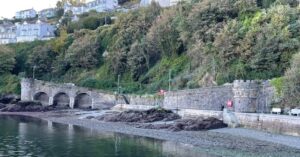 Pennyland, about which I have written a separate story
Pennyland, about which I have written a separate story
Standing on the quay and fishing for crabs was, and still is, a popular pastime for young children. A line baited with a small piece of fish will attract them and very soon a box will be brimming with the creatures. They grip onto the tasty morsel and will not let go. I watched a few children doing this recently but have to say that I am sure that the ones we used to catch were much larger. Anyway, like me, they eventually returned their catch, unharmed, to the river.
Now, do I remember the trains steaming along the East Looe Quay (Bullers Quay) or is my memory playing tricks again? Well, having checked the dates and noted that it closed in 1916, it’s clear it’s all In my imagination but what a sight it must have been. A comment in About Looe tells of a collapse into the river of the greater part of the lower quay between Quay Heads at East Looe taking with it some railway trucks. This must have been around the time of the closure.
 A steam engine and wagons heading for Buller’s Quay
A steam engine and wagons heading for Buller’s Quay
Shark Fishing is synonymous with Looe and much has been written about it, but despite my joy of catching a few crabs and mackerel, I was not a fan of this particular sport.
Looe’s present bridge dates from the 1850s and is a major feature of the twin towns being the only road crossing. However, it was not the first: there was a much earlier wooden version which burnt down in the early 1400s. Was it due to the two communities not wishing to mix, I wonder? A replacement opened in the 1430s and although reports of it vary in terms of length, width and in the number of arches, all seem to agree that it was about one hundred metres downstream and had a chapel in its centre.
I believe that Looe has had more than one cinema but the one that I remember was the Regent, next to the river and the town bridge. I don’t suppose we went there often but there were occasional visits with our Mum and Aunt. Apparently, it opened in 1933 as the Pavilion and showed films until sometime around 1960.
The town’s most famous feature must be its pier, widely known as the Banjo Pier. I well remember dangling my fishing line from its drum-head and catching… nothing. My skill as a fisherman probably matches that displayed in a number of other sports. This was not Looe’s first pier but the 1896 banjo-shaped addition was innovative and effective in preventing the harbour silting up. It was designed by Cornish architect Joseph Thomas (1838-1901), who was involved in many other aspects of the town’s development including the access road to Hannafore and parts of the Liskeard-Looe railway. Joseph was given the task of designing a pier to overcome the problem of silting up to the harbour entrance. The first attempt had been a curved version but it was not as successful as hoped so, in the late 1890s, he began work on an innovative design which included a circle at the seaward end, in the shape of a banjo. It was the first such design in the world but what led him to this novel solution is unknown. Full of confidence and with a good appreciation of seawater dynamics, he offered to pay for the work if it failed to solve the problem. It was a success and he did not have to dip into his own bank account. The pier is certainly a delight and a feature of which the townsfolk must be very proud.
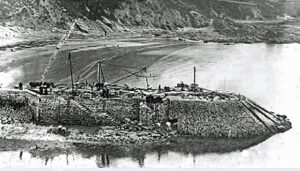 Looe Banjo Pier being constructed (Photo: unknown copyright)
Looe Banjo Pier being constructed (Photo: unknown copyright)
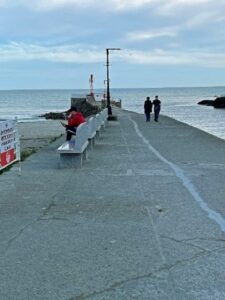 A stroll along the Banjo Pier
A stroll along the Banjo Pier
For a while, Aunty Barbara worked in a little grocery shop near West Looe Quay. I have always referred to it as octagonal in shape but now I find that even my memory of that is wrong. While on holiday there I often helped her there so that is another of my little claims to fame. I think that it has since had a variety of uses and is now an estate agent’s office.
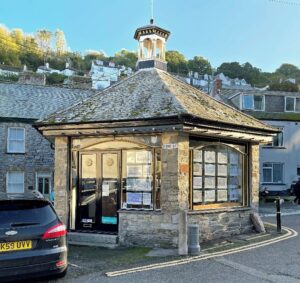 The 1853 shop at West Looe
The 1853 shop at West Looe
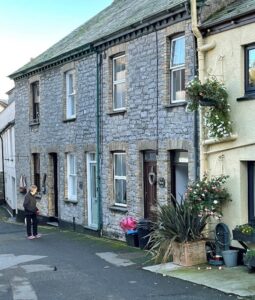 The shop was located near their home but I can’t remember which door was theirs.
The shop was located near their home but I can’t remember which door was theirs.
I suppose that I must have been sixteen when I had my first trip to a pub – later than some but earlier than I will admit to in court. It was my Uncle John who introduced me to that downward spiral as he led me into the Jolly Sailor in West Looe. He had moved to the town in 1951, when he ceased working at Trenderway Farm, and I was always amazed how he seemed to know everyone there.
The narrow streets and alleyways of both East and West Looe have changed little across the years and long may they remain. They add to the character of the two towns which were considered of such importance that up until the Reform Act of 1832, each returned two Members of Parliament.
As I grew older, other interests occupied my time and the visits to Looe became less frequent. David and I played in St Agnes Silver Band and during the 1960s we persuaded the other members to take part in a two-concert visit to Looe. It was enjoyable and the collecting boxes evidenced that such concerts were popular and a delight for both locals and visitors.
I will finish with what is for me, an aspect of supreme delight – the Liskeard to Looe Railway. The thrill of making this trip with my Mum, Dad and David, on a steam train beside the meandering East Looe River has been one of the joys of my life. I well remember introducing my own children to it and failing to tell them that, because of the steep decline from Liskeard Station, the train changes direction at Coombe Junction. The passenger service began in 1901, and in 1963 came the threat of closure under the Beeching/Marples axe. The decision was rescinded and how grateful we should be. Now, the diesel units travel alongside the old canal, through St Keyne Station (Wishing Well Halt), Causeland Station, Sandplace Halt and finally draws into Looe Station. Not the grand building that it once was but still there to provide today’s children with an experience which has delighted youngsters for well over a century.
I will repeat what I said at the beginning, this has not been an attempt to write the history of Looe: that is best left to those who have lived there for far longer than I. It is, however, my memory of a place for which I have a deep and warm affection: I hope that has been apparent in this article.
End notes:
- The internet includes more than one reason as to why Barcelona was so named. This is my favourite and if ‘tid’n true then it oughta be! “As I understand it, Barcelona came from the fact that the son of Lord Trelawny was shipwrecked and was saved by someone from Barcelona. To thank this person, the lord gave him this little triangle of land which has been called Barcelona ever since.”
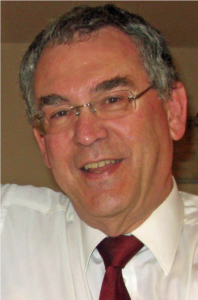
Tony Mansell is the author of several books on aspects of Cornish history. In 2011 he was made a Bardh Kernow (Cornish Bard) for his writing and research, taking the name of Skrifer Istori. He has a wide interest in Cornish history, is a researcher with the Cornish National Music Archive specialising in brass bands, and a sub-editor with Cornish Story.

Lovely story Tony. You must have had great fun Tony recalling all these memories of your childhood. Great stuff.A lot of the places you write about I remember visiting with my father and Uncle Reg.
A very entertaining ‘story’ which made me smile – many of the places mentioned are still there!
Thanks Susan
Can you please give me any info about a holiday location with wooden cabins, named after Red Indians.. it was situated not far from the East Side of Looe, down a long narrow lane in a valley. I stayed there with my mum and dad and aunt and uncle in 1959 I believe. I can find no information about it now. Many thanks.
Sorry, I can’t Dianne.
Wonderful…my links with Looe (at 55 I finally got to live here up West Looe Hill after a lifetime ‘trapped’ up country) are far more tenuous than yours,Grandad was a Cornishman and buried in St Cleer,Dad had come down with him and the family from London to swerve the forced evacuation.Dad worked at Vennings in Liskeard as a teen while all the men were away at war and loved a ride out to Looe on the dray…being a Cockney boy he had never seen the sea.Grandad was a sailor ( Merchent and RN).Grandad died,Dad joined the Army in late ’44 and never returned until my Aunt and Uncle convinced him and Mum to bring us down in ’71 and that’s where MY story starts in LOOE (Margaret Dan’s tea shop to be exact).
So thankyou for the Pennyland story, I have told visitors many times what it was called but now have good info why!
Thanks again
Thanks for your kind comments Johnny. It certainly is a wonderful place and my memories are treasured. Best, Tony